A creator of a $314 billion financial ecosystem, dressed in a simple T-shirt, contemplating the future of humanity.
Written by: Token Dispatch and Thejaswini M A
Translated by: Block unicorn
Preface
A creator of a $314 billion financial ecosystem, dressed in a simple T-shirt, contemplating the future of humanity.
Vitalik Buterin, also respectfully known as "V God" in the industry, is a Russian-born genius who created Ethereum, changing the concepts of finance, art, governance, and digital ownership.
The entire ecosystem exists under his architectural shadow.
His influence extends from boardrooms on Wall Street to developer hackathons across six continents. Central banks are building central bank digital currencies (CBDCs) based on his designs. The Ethereum Virtual Machine (EVM) powers thousands of projects that handle billions of transactions daily.
When he speaks, the market fluctuates. When he writes code, the industry transforms. When he donates $1.14 billion to charities, he does so without public announcement.
As Ethereum as an ecosystem continues to advance in the crypto world, it is undergoing a difficult period, and Vitalik seems to be orchestrating his grandest vision yet: to completely rebuild it while Ethereum continues to operate.
This genius, once reduced to tears over video games, is now the most influential technical expert in the most significant financial revolution of our time.
From Russia to Canada: Early Years
Vitalik was born on January 31, 1994, in Kolomna, about 113 kilometers southeast of Moscow, during the tumultuous post-Soviet era in Russia.
His father, Dmitry Buterin, was a computer scientist, laying the foundation for Vitalik's connection with technology.
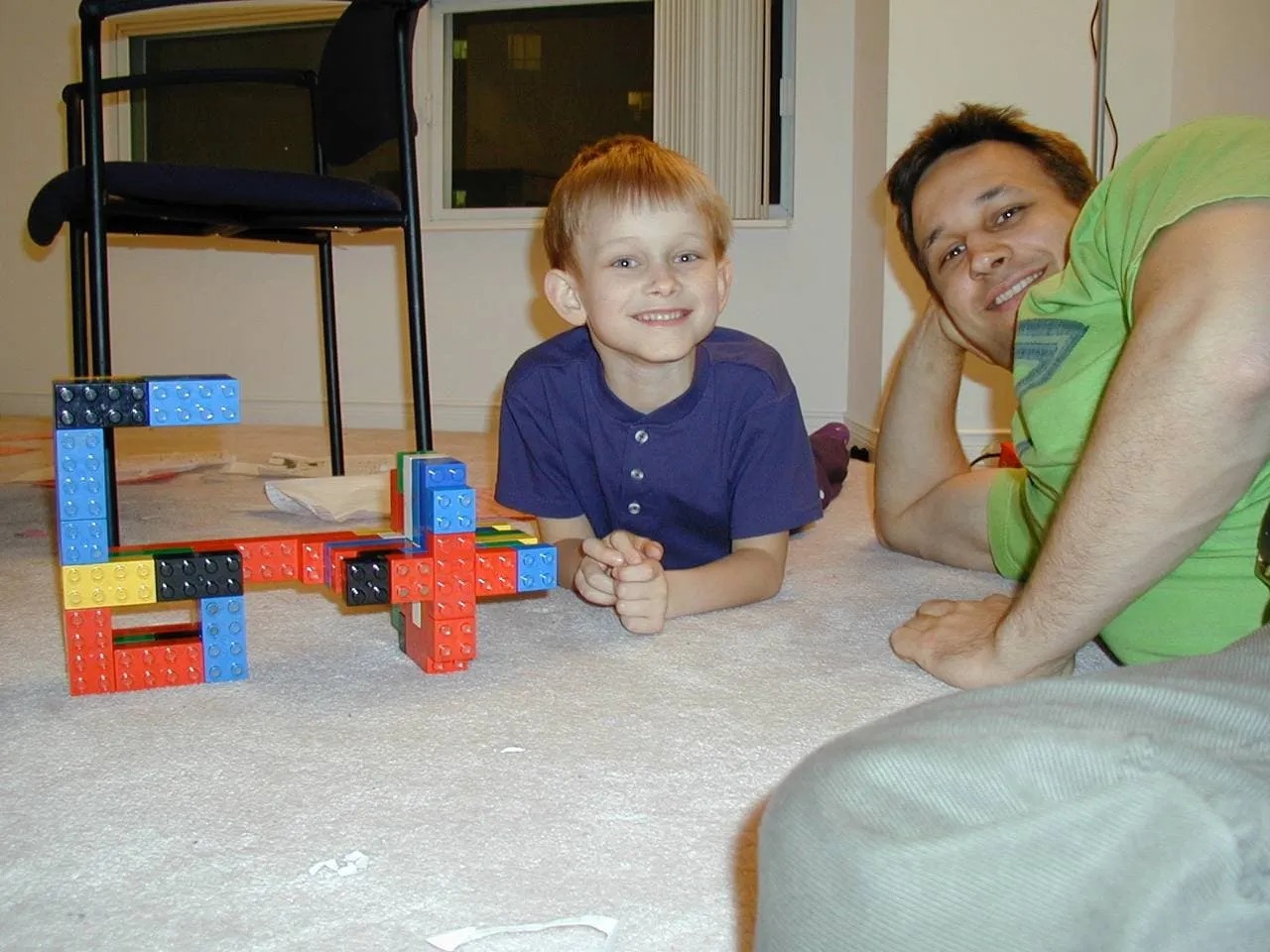
Vitalik and his father, Dmitry Buterin
When Vitalik was six, his family immigrated to Canada in search of better economic opportunities. This move marked the beginning of a new chapter, and Vitalik's intellectual gifts began to emerge.
In elementary school in Canada, teachers quickly recognized his mathematical talent. He could add and subtract three-digit numbers in his head at twice the speed of his peers. This led to him being placed in a gifted children's program, where Vitalik began to realize he was different—especially drawn to mathematics, programming, and economics.
"I was never particularly inspired by the traditional education system," Vitalik later wrote. But when he entered a private high school in Toronto, Abelar School, his perspective changed dramatically. The school's environment encouraged knowledge exploration and critical thinking, transforming Vitalik's relationship with learning.
His academic abilities continued to shine. In 2012, he won a bronze medal at the International Olympiad in Informatics, proving his programming prowess on the global stage. However, perhaps the most critical moment in his intellectual development did not occur in the classroom but through a video game.
From 2007 to 2010, Vitalik was immersed in World of Warcraft. When the game developers decided to remove the damage component of his beloved warlock skill "Life Tap," he was deeply affected—reportedly crying himself to sleep that night. This experience gave him a profound understanding of centralized control.
This experience prompted him to seek alternative systems, free from a single authority's arbitrary rule changes.
The Awakening to Bitcoin
At 17, Vitalik's father introduced him to Bitcoin. The concept piqued his interest and led him to conduct deeper research.
Wanting to participate in this emerging economy but lacking the computational power to mine or the funds to buy Bitcoin, Vitalik chose an unconventional path: he began writing articles about cryptocurrency for a blog, earning 5 bitcoins (worth about $3.50 at the time) for each piece.
These early articles caught the attention of Romanian Bitcoin enthusiast Mihai Alisie. In September 2011, they co-founded Bitcoin Magazine, establishing one of the first serious publications focused on cryptocurrency. Despite his youth, Vitalik's articles displayed a technical depth and thought that surpassed his age.
Over the next two and a half years, Vitalik immersed himself in the Bitcoin ecosystem, gaining a deep understanding of the potential and limitations of blockchain technology.
By 2013, Vitalik decided to fully commit to cryptocurrency, dropping out of his computer science program at the University of Waterloo.
"I remember the day he came back from university. His mom was visiting us at the time, so when he walked in, the three of us were there—me, Maya, and Natalia. Then he said, 'Hey guys, I'm actually thinking about dropping out,'" his father Dmitry recalled.
He spent six months traveling the world, talking to developers and exploring various blockchain projects. His discoveries revealed a truth: most projects were too narrowly focused on specific applications.
This observation sparked a key insight: what if blockchains could be programmed to accomplish almost any task, not just process financial transactions? What if developers could build applications directly on the blockchain?
By the end of 2013, at just 19 years old, Vitalik wrote a white paper outlining his vision for Ethereum—a platform that transcended Bitcoin's limited functionality, becoming a fully programmable blockchain capable of supporting almost any application developers could imagine.
The Birth of Ethereum
Vitalik's Ethereum white paper proposed a radical vision: a blockchain with a Turing-complete programming language that could theoretically solve any computational problem given enough time and memory. At its core was the concept of "smart contracts": self-executing agreements with terms directly written into code.
The response was swift and enthusiastic.
Within weeks, a group of programmers, including Gavin Wood, Joseph Lubin, and Charles Hoskinson, rallied around Vitalik's vision. In January 2014, they announced the birth of Ethereum.
To raise development funds, the team held an initial coin offering (ICO) in July 2014, exchanging Ether (ETH) tokens for Bitcoin. The offering raised about 31,000 bitcoins, worth approximately $18 million at the time—this substantial sum indicated immense confidence in the project's potential.
Meanwhile, Vitalik received a $100,000 Thiel Fellowship established by PayPal co-founder Peter Thiel, aimed at supporting young entrepreneurs willing to drop out or skip college to pursue their ideas. This funding allowed Vitalik to dedicate himself full-time to Ethereum.
After extensive development and testing, Ethereum officially launched on July 30, 2015. The first version was called "Frontier," which, while basic, was fully functional, providing developers with a platform to start building decentralized applications.
Ethereum's design introduced several key innovations:
An account-based model, rather than Bitcoin's UTXO (unspent transaction output) system
Smart contracts that support complex self-executing agreements
A gas mechanism to measure and limit computational work
The Ethereum Virtual Machine (EVM), a Turing-complete execution environment
These features made Ethereum more flexible than Bitcoin, opening the door to applications that went beyond simple value transfer. Developers could now create token systems, financial derivatives, decentralized autonomous organizations (DAOs), identity systems, and more on a single blockchain platform.
However, the launch of Ethereum was not without challenges. In 2016, a decentralized venture capital fund project called The DAO was hacked due to a code vulnerability, with hackers stealing millions of dollars worth of Ether, putting the young platform in a survival crisis.
The community faced a tough choice: should they modify the blockchain to recover the stolen funds, violating the principle of immutability, or accept the losses to maintain the philosophical integrity of the system?
Vitalik advocated for a "soft fork" to restore the funds. This position sparked controversy, leading to a split in the community and ultimately resulting in a "hard fork" of the blockchain. The outcome was the creation of two independent chains: Ethereum (the modified chain that recovered the stolen funds) and Ethereum Classic (the original unaltered chain).
This decision showcased a pragmatic side of Vitalik's leadership: a willingness to prioritize user protection over strict adherence to ideological principles. This pragmatism has been a consistent theme in his subsequent approach to Ethereum's development.
Technical Vision and Evolution
Ethereum has always embraced continuous evolution. The refusal to cling to traditional architectures is both Ethereum's greatest strength and its biggest challenge.
The platform's price chart tells a story of extreme volatility—from a few cents at launch to nearly $4,900 in November 2021, then plummeting below $1,000 during the crypto winter of 2022, and now stabilizing at $2,605. Over the past decade, these fluctuations have tested the resolve of ETH supporters, who have endured promised upgrades, delayed timelines, and technological transformations.
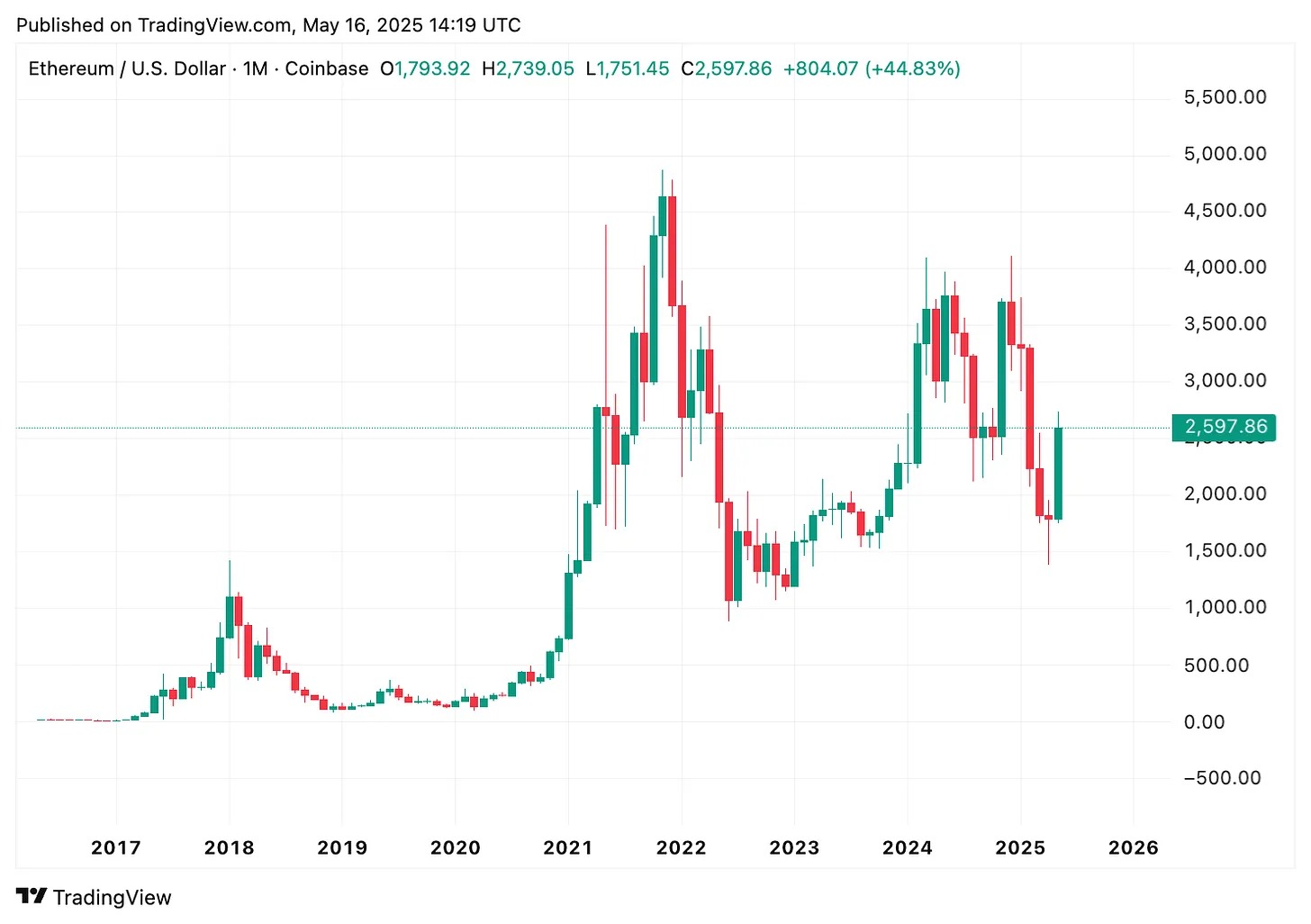
For Ethereum's believers, this journey has been an emotional rollercoaster. Early supporters envisioned rapid scaling solutions but had to exercise immense patience through years of development cycles. Some gave up during the lows, while the most loyal members of the community—"ETH maximalists"—maintained their faith through multiple market cycles.
Many critics overlook that Ethereum's seemingly slow development pace is, in fact, meticulously designed. Vitalik has always been at the forefront of community development.
As a truly community-driven protocol, every major upgrade requires extensive research, multiple implementations, community debates, and rigorous testing. This governance model prioritizes security and consensus over speed—necessary when handling hundreds of billions of dollars in value.
Ethereum's decade-long journey has crossed several significant milestones.
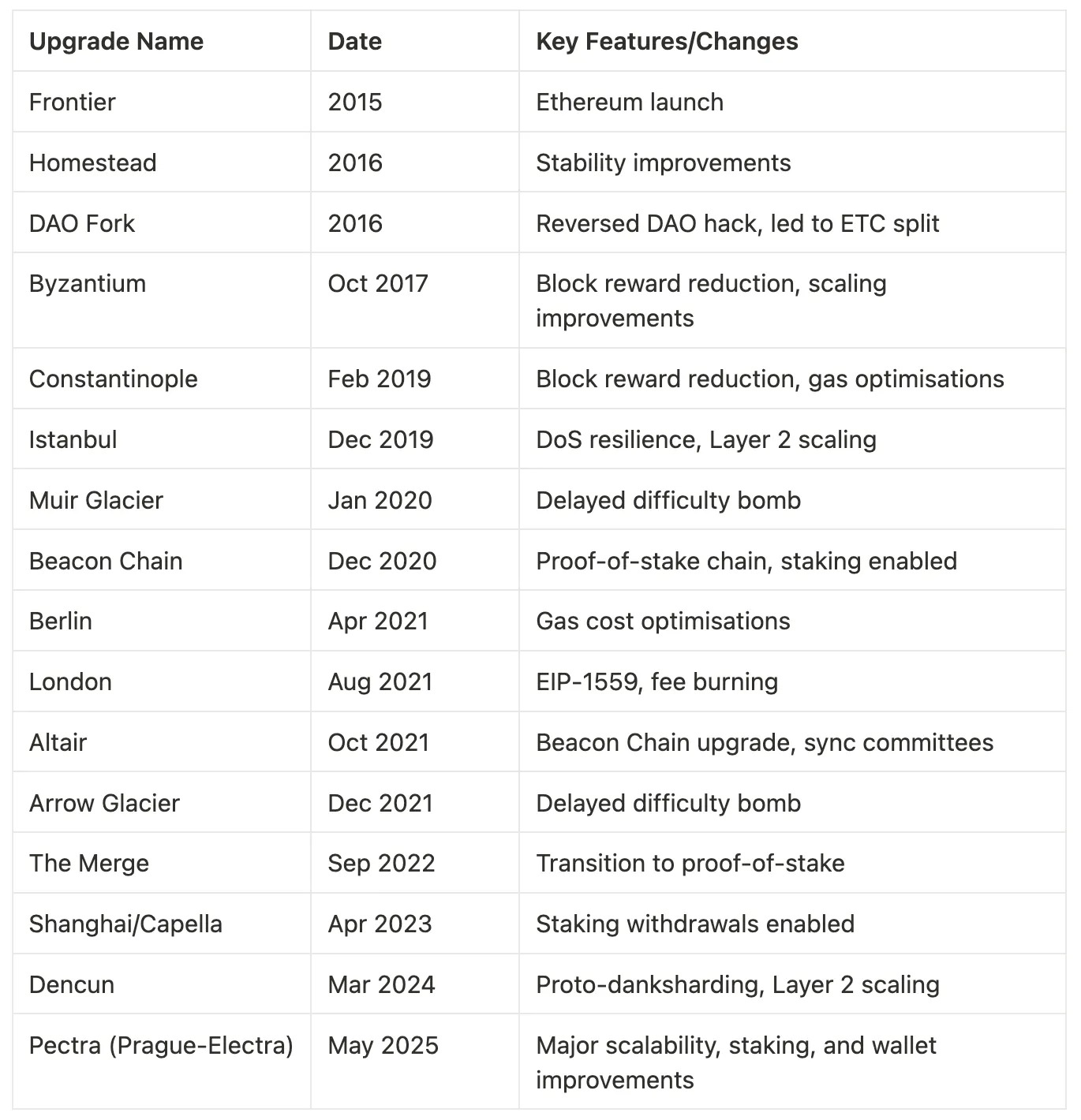
The roadmap for Ethereum's future development, as outlined by Vitalik, revolves around several key phases, whimsically named:
The Merge: Completing the transition to Proof of Stake (PoS)
The Surge: Implementing sharding to enhance scalability
The Verge: Introducing Verkle trees to improve efficiency
The Purge: Reducing storage requirements
The Splurge: Enhancing quantum resistance
The recent Pectra upgrade (May 2025) advanced this roadmap by improving wallet functionality and validator economics, but the true north star remains Vitalik's vision: a blockchain serving as a global neutral infrastructure for coordination and value exchange.
For validators, this upgrade raises the maximum staking limit from 32 ETH to an astonishing 2048 ETH, significantly reducing operational costs for institutional stakers. These improvements have propelled ETH out of its recent price slump, climbing from around $1615 in mid-April to over $2600 today, an increase of more than 60%.
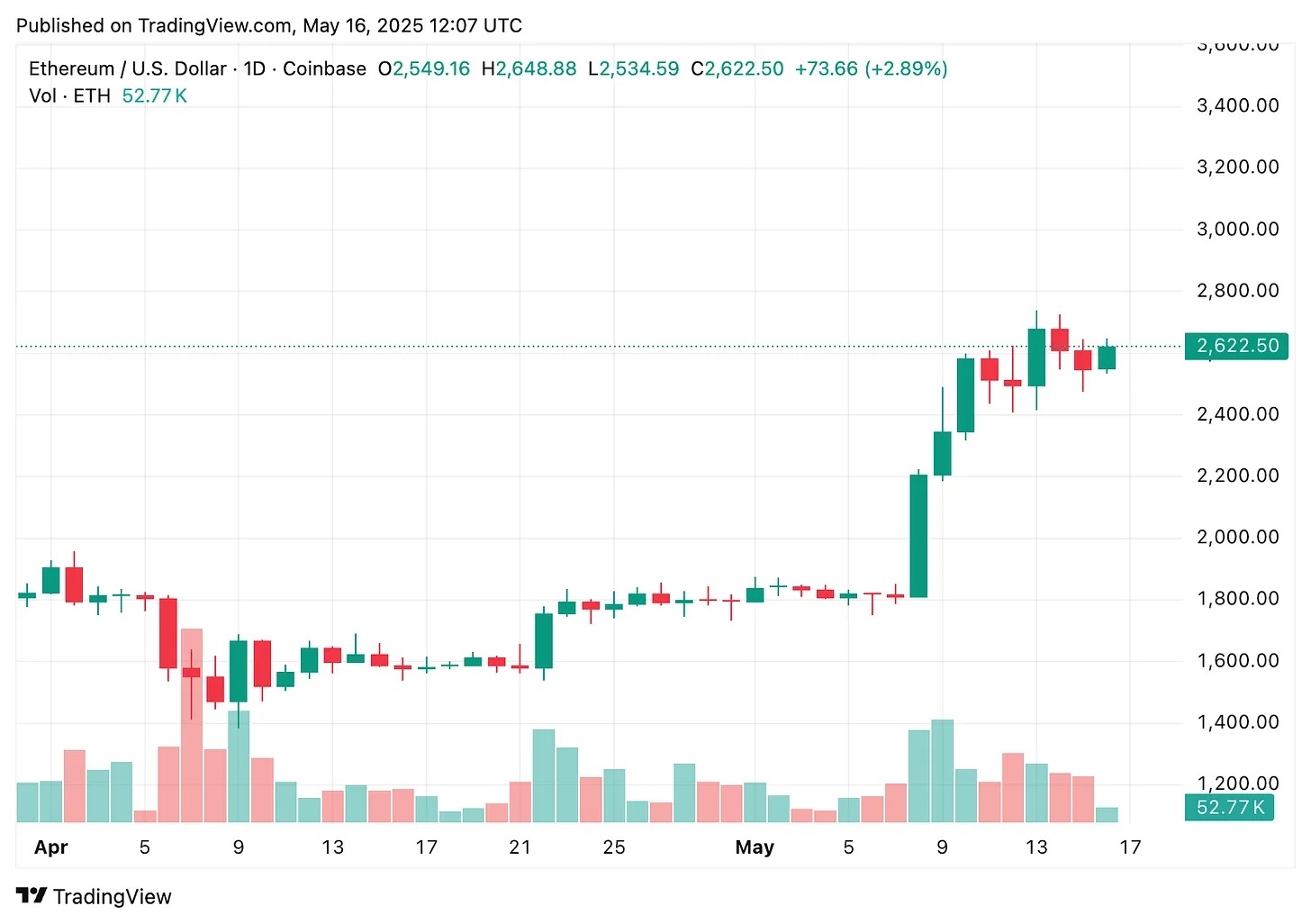
However, just days before the launch of Pectra, Vitalik published a seemingly contradictory vision in his blog post "Simplifying L1," arguing that Ethereum must become "almost as simple as Bitcoin" within five years.
He proposed replacing the Ethereum Virtual Machine with RISC-V (an open-source instruction set architecture), claiming it could bring a "100-fold performance improvement" while making the system more developer-friendly.
This apparent contradiction—implementing the complex Pectra upgrade while advocating for a thorough simplification—reflects Buterin's pragmatic approach: planning a more elegant future architecture while making necessary improvements to the current system.
Philanthropist and Philosopher
In addition to his technical contributions, Vitalik often emerges as a philanthropist, using his cryptocurrency wealth to support various scientific, medical, and humanitarian causes.
In May 2021, he made headlines by donating $1.14 billion worth of Shiba Inu cryptocurrency (SHIB) to the India Crypto Covid Relief Fund to help combat the COVID-19 pandemic. This donation led to a significant drop in the coin's price but provided substantial aid at a critical moment.
His other significant donations include:
$665 million to the Future of Life Institute, focusing on reducing existential risks, including those from artificial intelligence
$763,970 worth of Ethereum to the Machine Intelligence Research Institute
$2.4 million worth of Ethereum to the SENS Research Foundation for research on rejuvenation and lifespan extension
$336 million worth of Dogelon Mars tokens to the Methuselah Foundation for longevity research
$9.4 million in USDC to the University of Maryland for research on germicidal ultraviolet light to prevent future pandemics
During the outbreak of the Russia-Ukraine war in 2022, Vitalik supported relief efforts through cryptocurrency donations and public stances, including participation in initiatives like Ukraine DAO.
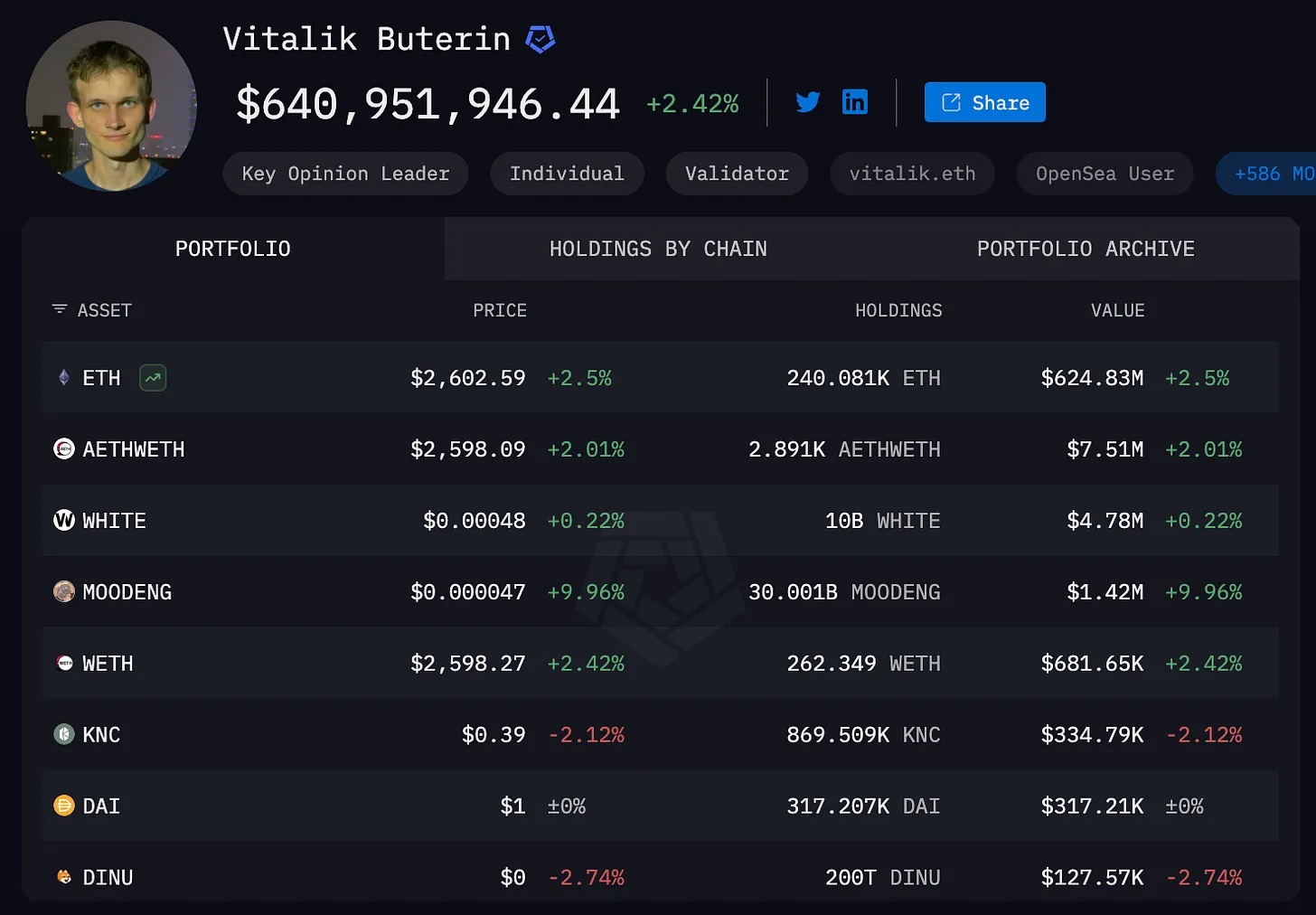
At the core of Vitalik's personal philosophy are principles of decentralization, egalitarianism, and the potential of technology to create positive social change. His thoughts have evolved over time, shifting from what he described as "anarcho-capitalist thinking" to a more "Georgist" perspective focused on public goods and common resources.
Recently, Vitalik expressed concerns about the existential risks that artificial intelligence may pose to humanity. In a blog post titled "My Technological Optimism" in November 2023, he argued that AI is "fundamentally different" from other inventions (like guns, airplanes, and social media) because it could develop a new form of "thinking" that might even be adversarial to humans.
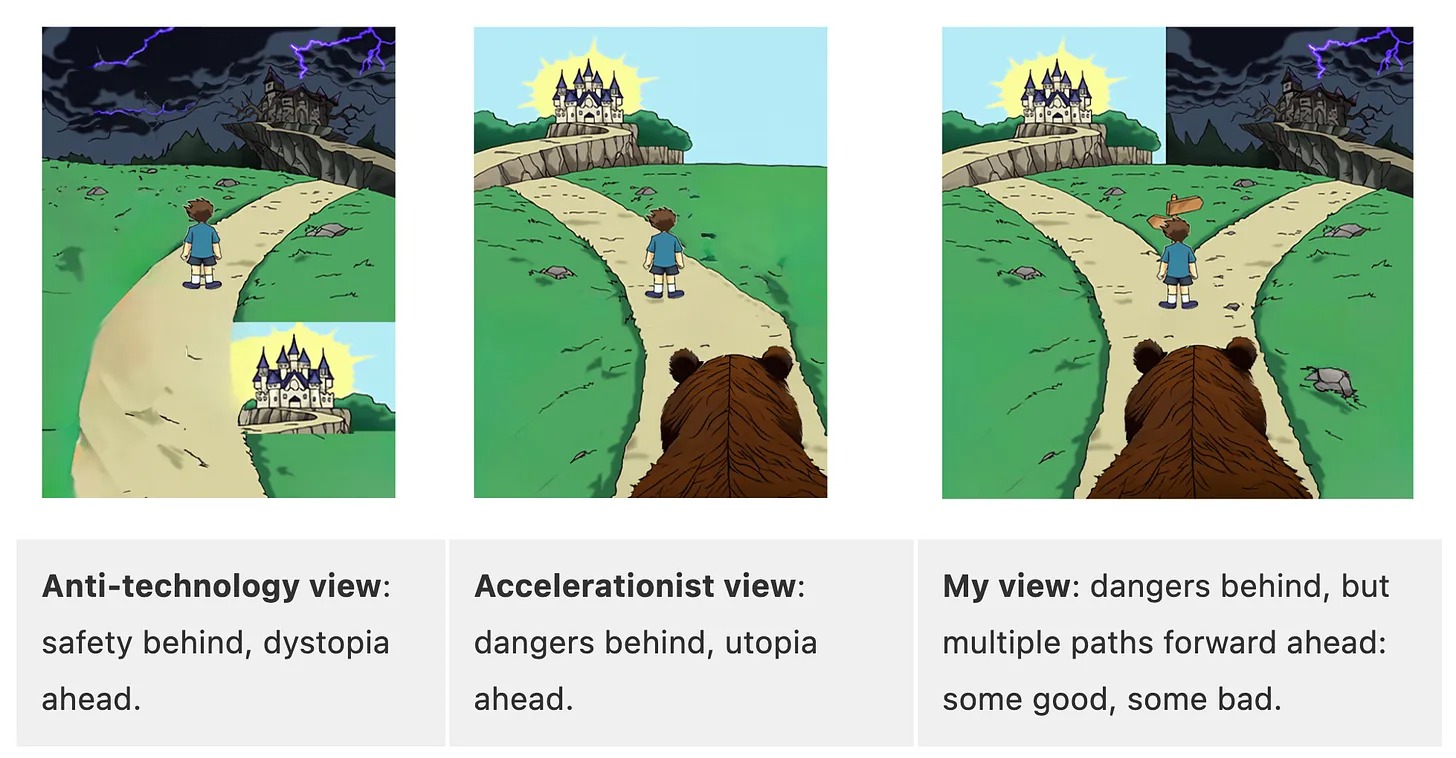
"If a superintelligent AI decides to turn against us, it could wipe out humanity entirely," Vitalik wrote. "Even Mars might not be safe."
In response to these concerns, he advocates for a philosophy he calls "d/acc," focusing on defensive, decentralized, democratic, and differentiated technological development. This approach aims to advance beneficial technologies while mitigating the risks of potentially harmful ones.
Our Perspective
Vitalik Buterin's story reveals the contradictory forces shaping the blockchain revolution. His journey is both deeply technical and rich in philosophy, challenging traditional narratives about tech founders and their creations.
Unlike the typical founder-CEO in Silicon Valley, Vitalik eschews the symbols of traditional corporate leadership. He does not lead through organizational authority but derives his influence from the persuasive power of the ideas he publicly articulates in blog posts and technical papers.
However, this leadership style also brings about tense relationships. Critics like Charles Hoskinson, founder of Cardano, argue that Ethereum's governance still relies too heavily on Vitalik's direction. "Everyone expects him to set the roadmap," Hoskinson pointed out at a recent conference. "What would the next hard fork look like if you removed him from the equation now?"
This criticism touches on the fundamental challenge of decentralized projects: how to balance visionary leadership with genuinely distributed governance. Ethereum's success partly stems from Vitalik's technical insights and roadmap, but its long-term resilience requires moving beyond reliance on any single individual.
Ethereum's current transformation—from the immediate technical improvements of the Pectra upgrade to Vitalik's longer-term vision of thorough simplification—represents not so much an isolated change but a fundamental recalibration of its approach. The recent positive market response indicates that investors believe in this dual strategy of immediate enhancements and long-term architectural innovation.
The contradiction between Vitalik's personal wealth and his philosophical commitments presents another paradox. While his net worth exceeds $1 billion, he lives simply, wearing modest clothing and focusing on intellectual rather than material pursuits. However, as one of Ethereum's largest token holders, he benefits economically from the platform's growth—this may conflict with the equitable, decentralized system he advocates.
His handling of these contradictions is quite enlightening. Vitalik does not pretend these contradictions do not exist; rather, he openly acknowledges them and examines the trade-offs of different developmental paths. This intellectual honesty stands in stark contrast to the exaggerated marketing and tribalism prevalent in the crypto space.
In a field dominated by extremism and absolutist thinking, Vitalik offers a different model: the courage to explore knowledge, the willingness to revise opinions, and a commitment to building technology that serves human values rather than merely disrupting existing systems. Whether this approach can withstand market pressures and competitive visions remains an open question—one that is likely to define the next chapter of both Ethereum and Vitalik's story.
免责声明:本文章仅代表作者个人观点,不代表本平台的立场和观点。本文章仅供信息分享,不构成对任何人的任何投资建议。用户与作者之间的任何争议,与本平台无关。如网页中刊载的文章或图片涉及侵权,请提供相关的权利证明和身份证明发送邮件到support@aicoin.com,本平台相关工作人员将会进行核查。




